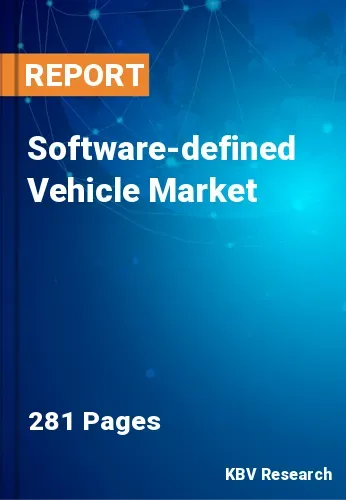The Global Software-defined Vehicle Market size is expected to reach $510.4 billion by 2030, rising at a market growth of 10.5% CAGR during the forecast period.
Powertrain & chassis applications utilize software to optimize the vehicle's energy usage and mechanical systems. Thus, the powertrain & chassis segment acquired $50,020.0 million in 2022. This can involve managing the power distribution in hybrid and electric vehicles for optimal efficiency and energy recovery through regenerative braking. Powertrain applications drive the adoption of electrification and hybridization. Electric powertrains and hybrid systems rely on software to manage the integration of electric motors with traditional internal combustion engines, optimizing energy usage and delivering improved fuel economy. Chassis and powertrain applications enable real-time monitoring and diagnostics of key vehicle components. Chassis applications use software to control torque vectoring and stability systems. These features enhance vehicle stability and handling in various driving conditions, improving safety and performance.
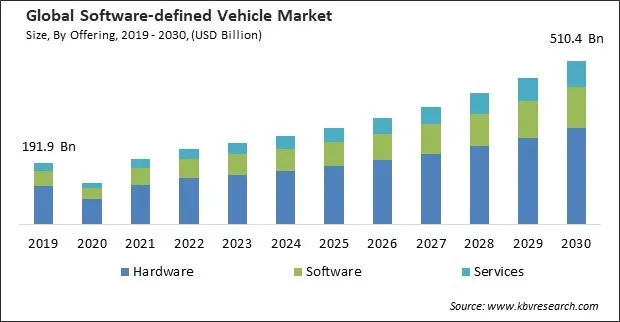
The major strategies followed by the market participants are Partnerships & Collaborations as the key developmental strategy to keep pace with the changing demands of end users. For instance, In September, 2023, Continental AG came into partnership with Google Cloud to develop an innovative lineup of automotive solutions that prioritize safety, efficiency, and user-centric features. alongside a set of management tools. Additionally, In August, 2023, Aptiv PLC came into partnership with Horizon Robotics to revolutionize China's automotive industry by leveraging its distinctive expertise, ultimately offering Chinese drivers and passengers a safer, more convenient, and enjoyable travel experience.
Based on the Analysis presented in the KBV Cardinal matrix; Harman International Industries, Inc. is the forerunners in the Market. In January, 2023, Harman International Industries came into partnership with Ferrari, an Italian luxury sports car manufacturer based in Maranello, Italy. Through this partnership, Ferrari would focus on bringing the next generation of in-cabin experiences to market with the help of Harman International Industries. Companies such as Volkswagen AG, Tesla, Inc., NVIDIA Corporation are some of the key innovators in the Market.
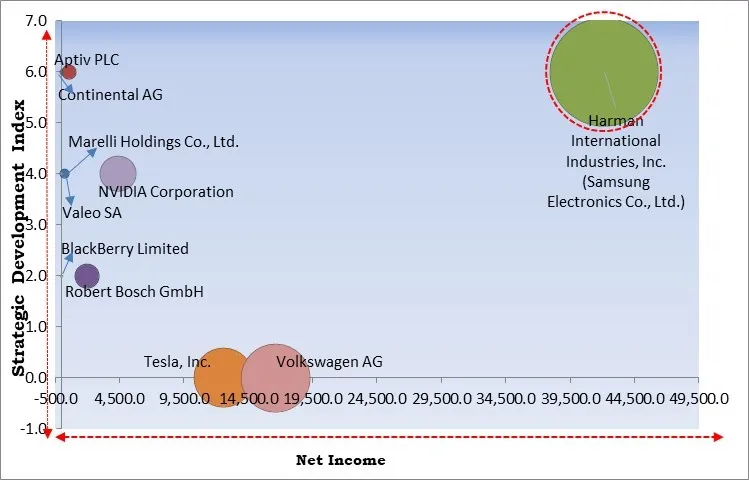
The development of autonomous vehicles relies on extensive software systems for perception, decision-making, and control. SDVs are a fundamental platform for autonomous driving development. Artificial intelligence and sophisticated machine learning algorithms are used for decision-making, path planning, and object recognition. High-definition maps and precise localization technologies, including GPS and inertial navigation systems, help autonomous vehicles understand their position relative to their environment. These maps are often combined with real-time sensor data for accuracy. The increasing number of autonomous driving technologies contributes to expanding the market.
Electric powertrains are highly software dependent. Software controls the electric motor's performance, delivering instant torque for acceleration and smooth operation. EVs often include user interfaces that provide information about the vehicle's range based on driving conditions. The software continuously calculates and updates these range predictions. This connectivity enables features like finding charging stations, reserving charging slots, and monitoring charging progress. Telematics systems in electric and hybrid vehicles provide real-time data on battery status, charging options, and energy consumption. This information is valuable for drivers and fleet managers. The expansion of the electric and hybrid vehicle industry is increasing the market.
Modern vehicles, especially autonomous or highly automated ones, rely on intricate software systems. Managing and maintaining this complexity can be challenging, involving multiple software layers and components. Ensuring the safety of complex software systems is a critical challenge. Developers rigorously test and validate software to minimize the risk of system failures or errors. Handling the vast amount of data generated by software-defined vehicles is complex. Efficient data storage, processing, and analysis are necessary, which can strain existing infrastructure. Integrating various vehicle systems, such as infotainment, connectivity, autonomous driving, and powertrain management, seamlessly and harmoniously is complex due to the diversity of technologies involved. Complexity and interoperability issues are significant challenges that can slow down the market growth.
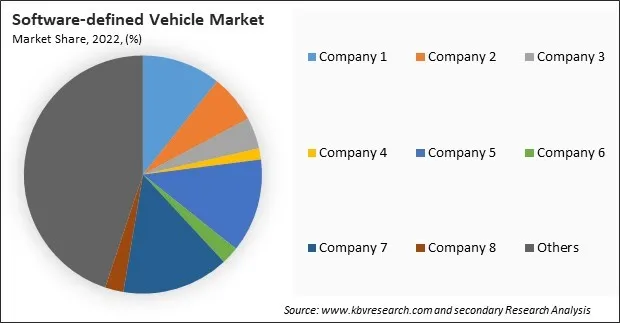
The leading players in the market are competing with diverse innovative offerings to remain competitive in the market. The above illustration shows the percentage of revenue shared by some of the leading companies in the market. The leading players of the market are adopting various strategies in order to cater demand coming from the different industries. The key developmental strategies in the market are Partnerships, Collaborations & Agreements.
By offering, the market is categorized into hardware, software, and services. In 2022, the hardware segment held the highest revenue share in the market. Advanced microprocessors and control units are the brains behind SDVs. These hardware components are responsible for processing the vast amount of data collected by sensors and making real-time decisions. High-performance processors, often with multiple cores, are used to run complex algorithms for tasks like object recognition and path planning. Connectivity is a fundamental aspect of software-defined vehicles. Hardware modules for cellular, Wi-Fi, and V2X (vehicle-to-everything) communication enable data exchange between vehicles, infrastructure, and the cloud. These modules support remote software updates, data sharing, and vehicle-to-vehicle communication for enhanced safety and traffic management.
By application, the market is segmented into powertrain & chassis, ADAS/HAD, body & energy, infotainment, and connectivity & security. The powertrain & chassis segment recorded a remarkable revenue share in the market in 2022. Powertrain & chassis applications utilize software to optimize the vehicle's energy usage and mechanical systems. This can involve managing the power distribution in hybrid and electric vehicles for optimal efficiency and energy recovery through regenerative braking. Powertrain applications drive the adoption of electrification and hybridization.
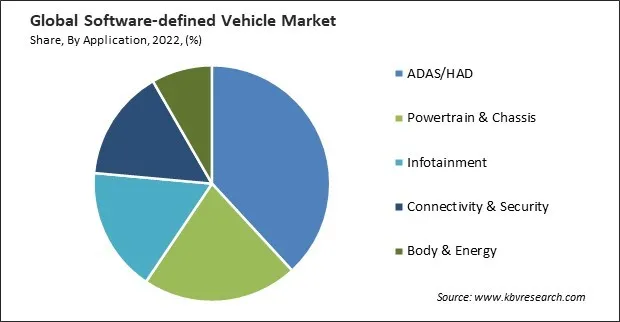
Based on vehicle type, the market is classified into ICE, BEV, and HEV/PHEV. The HEV/PHEV segment acquired a substantial revenue share in the market in 2022. HEVs and PHEVs combine traditional internal combustion engines (ICE) with electric propulsion systems. Integrating electric power allows these vehicles to operate more efficiently, reducing fuel consumption and emissions. In the context of SDVs, efficiency is essential for optimizing powertrain performance and extending the range of electric-only driving. HEVs and PHEVs feature regenerative braking systems that capture and store energy during braking and deceleration. This energy is subsequently used to recharge the vehicle's battery. Regenerative braking systems are an essential part of energy efficiency in SDVs.
| Report Attribute | Details |
|---|---|
| Market size value in 2022 | USD 235.1 Billion |
| Market size forecast in 2030 | USD 510.4 Billion |
| Base Year | 2022 |
| Historical Period | 2019 to 2021 |
| Forecast Period | 2023 to 2030 |
| Revenue Growth Rate | CAGR of 10.5% from 2023 to 2030 |
| Number of Pages | 281 |
| Number of Table | 372 |
| Report coverage | Market Trends, Revenue Estimation and Forecast, Segmentation Analysis, Regional and Country Breakdown, Competitive Landscape, Companies Strategic Developments, Company Profiling |
| Segments covered | Offering, Vehicle Type, Application, Region |
| Country scope | US, Canada, Mexico, Germany, UK, France, Russia, Spain, Italy, China, Japan, India, South Korea, Singapore, Malaysia, Brazil, Argentina, UAE, Saudi Arabia, South Africa, Nigeria |
| Growth Drivers |
|
| Restraints |
|
Region-wise, the market is analysed across North America, Europe, Asia Pacific, and LAMEA. In 2022, the Asia Pacific region led the market by generating the highest revenue share. The Asia Pacific region is leading the world in the adoption of EVs, with China being the largest EV sector. Many startups in the Asia Pacific region focus on developing mobility solutions and SDV technologies. Many cities in the region embraced smart city concepts, leading to the integration of software-defined mobility solutions.
Free Valuable Insights: The Global Software-defined Vehicle Market size to reach USD 510.4 Billion by 2030
The market research report covers the analysis of key stake holders of the market. Key companies profiled in the report include Robert Bosch GmbH, Continental AG, Valeo SA, Aptiv PLC, Marelli Holdings Co., Ltd., Tesla, Inc., NVIDIA Corporation, Volkswagen AG, Harman International Industries, Inc. (Samsung Electronics Co., Ltd), BlackBerry Limited, Medtronic PLC
By Offering
By Application
By Vehicle Type
By Geography


This Market size is expected to reach $510.4 billion by 2030.
Expansion of autonomous driving technologies are driving the Market in coming years, however, Complexity and interoperability issues restraints the growth of the Market.
Robert Bosch GmbH, Continental AG, Valeo SA, Aptiv PLC, Marelli Holdings Co., Ltd., Tesla, Inc., NVIDIA Corporation, Volkswagen AG, Harman International Industries, Inc. (Samsung Electronics Co., Ltd), BlackBerry Limited, Medtronic PLC
The expected CAGR of this Market is 10.5% from 2023 to 2030.
The ADAS/HAD segment acquired the maximum revenue in the Market, by Application in 2022; thereby, achieving a market value of $184.8 billion by 2030.
The Asia Pacific region dominated the Market, by Region in 2022, and would continue to be a dominant market till 2030; thereby, achieving a market value of $202.8 billion by 2030.
Our team of dedicated experts can provide you with attractive expansion opportunities for your business.
